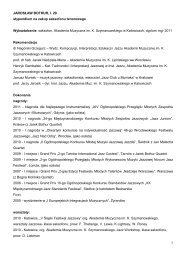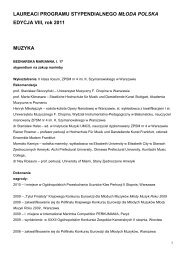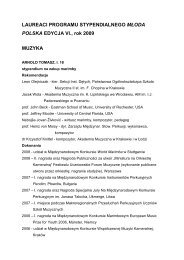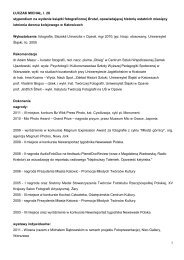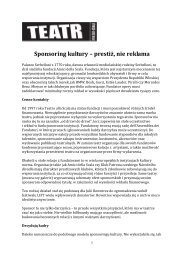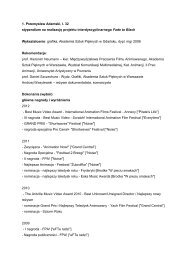Untitled - Narodowe Centrum Kultury
Untitled - Narodowe Centrum Kultury
Untitled - Narodowe Centrum Kultury
Create successful ePaper yourself
Turn your PDF publications into a flip-book with our unique Google optimized e-Paper software.
tytuł artykułu 27<br />
It is difficult to work single-handedly<br />
in culture. Cultural institutions don’t<br />
exist in a vacuum, but in a network<br />
of social and cultural relationships.<br />
Cultural projects, large and small,<br />
require not only collaboration with<br />
partners but also close ties with the<br />
surrounding community. To implement<br />
them we need partners – sometimes<br />
a few, often more than ten or twenty.<br />
A good experience with project partnerships paves the way for<br />
longer-lasting cooperation in the form of other joint projects or strategic<br />
partnerships.<br />
strategic partnerships<br />
These include not only actions necessary to carry out individual projects<br />
but also permanent collaboration based on common goals. Strategic<br />
partnerships last longer than project partnerships and involve<br />
actions taken to achieve goals set by the partners.<br />
Strategic partnerships within the field of culture are rare.<br />
Much more often they are cross-sector partnerships, such as those<br />
designed to promote a region, tourism, safety or solutions to social<br />
issues. In such arrangements, partners from different sectors share<br />
clearly defined areas of operation. Typically, all partners in a strategic<br />
partnership have equal status and act together. Their activities<br />
may focus on general issues, legal solutions, industry or local<br />
policies and on implementing a jointly developed strategy. The best<br />
example of a partnership pursuing a common strategy are local action<br />
groups.<br />
Another example is coalition partnership, a model that has<br />
recently been gaining ground in Poland. Coalitions bring together<br />
institutions and organisations from various industries in order<br />
to undertake a specific, usually short-term, action. Despite varying<br />
interests and goals, they unite, since joint action allows them to<br />
meet the needs of all coalition partners. One example of such coalitions<br />
are joint efforts of different organisations to change the national<br />
or local legislation, procedures and solutions unfavourable to<br />
coalition partners.<br />
Another are formal and informal organisations that engage<br />
in the debate on cultural policies in Poland. This leads to the formation<br />
of independent civil movements, e.g. the Committee for Radical<br />
Cultural Change (Poznań); European Area of Culture Consortium,<br />
Szczecin 2016; Warsaw 2020 Initiative, a coalition of artists, activists<br />
and cultural managers who advocate change in Warsaw’s cultural policy;<br />
and 2010 Culture Citizens.<br />
cross-sector partnerships<br />
Nowadays cultural activities are not the sole domain of public cultural<br />
institutions run by the central government or local authorities. Citizens<br />
– including artists, culture animators and activists – work for<br />
non-profit organisations, associations and foundations.<br />
Culture is also part of the private sector. Companies operating<br />
in the cultural field make up the creative industry. Representatives<br />
of all three sectors can appreciate and use their unique potentials:<br />
the permanence, continuity and infrastructure of the public sector;<br />
the dynamism, passion and willingness for voluntary action of the<br />
social sector; and the capital resources and market skills of the private<br />
sector. Local partnerships are often impossible without the support<br />
of the Church and other religious organisations that bond local<br />
communities.<br />
To be efficient, cross-sector partnership must be complete and<br />
complementary. One example of cross-sector partnership is plaza24.pl.<br />
Operated from Płaza, a small village in Chrzanów District, Lesser Poland<br />
Province, this online venture involves the most prominent public<br />
and private sector players, including the village administrator, the local<br />
school, the parish, two associations, a sports club, health centre,<br />
beekeeping farm, welfare home, voluntary fire brigade and kindergarten.<br />
The leader’s mantle was taken up by a public library.<br />
what forms can cultural partnerships take<br />
Formalised project partnerships typically involve partnership agreements<br />
for specific projects. Parties to the agreements are legal entities:<br />
cultural institutions, NGOs, businesses. One of the parties takes<br />
the leader role, and the parties define their roles, responsibilities and<br />
rights, financial terms, third party liability, the period of the agreement,<br />
and settlement of disputes.<br />
An example of formalised cross-sector partnership is a partnership<br />
formed in Szczecin to mark the Year of Chopin in 2010 as<br />
part of the project Beyond Time and Space (funded by the Ministry<br />
of Culture and National Heritage, the city of Szczecin and from<br />
the partners’ own resources). Partners included the Mieczysław<br />
Karłowicz Philharmonic in Szczecin, Szczecin Artistic Agency, 13<br />
Muses Club Community Centre, Szczecin 2016 and the following<br />
NGOs: Artelier Foundation, Boogie Brain Association of Cultural



